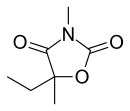Paramethadione
Paramethadione (brand name Paradione) is an anticonvulsant in the oxazolidinedione class developed by the Illinois-based pharmaceutical company Abbott Laboratories (known as AbbVie since January 1, 2013 [1]), and approved by the Food and Drug Administration in 1949 for the treatment of absence seizures, also called partial seizures.[2][3]
 | |
| Clinical data | |
|---|---|
| AHFS/Drugs.com | Micromedex Detailed Consumer Information |
| ATC code | |
| Pharmacokinetic data | |
| Protein binding | Not significant |
| Identifiers | |
| |
| CAS Number | |
| PubChem CID | |
| IUPHAR/BPS | |
| DrugBank | |
| ChemSpider | |
| UNII | |
| KEGG | |
| ChEMBL | |
| CompTox Dashboard (EPA) | |
| ECHA InfoCard | 100.003.726 |
| Chemical and physical data | |
| Formula | C7H11NO3 |
| Molar mass | 157.169 g·mol−1 |
| 3D model (JSmol) | |
| Chirality | Racemic mixture |
| |
| |
| (verify) | |
In 1960, the yearly cost for 900 mg/day paramethadione was approximately $66,[4] which would translate to $462 yearly in 2007 (with CPI inflation) if paramethadione was still sold.[5]
Mechanism of Action
Paramethadione acts to reduce T-type calcium currents in thalamic neurons which has been proposed to underlie the 3-Hz spike-and-wave discharge seen on electroencephalogram (EEG) during absence seizures.[6][7]
Adverse Effects
Paramethadione is associated with various adverse effects including sedation, increased visual sensitivity to light, GI distress, edema, nephropathy, neutropenia, myasthenia gravis-like syndrome, fatal aplastic anemia, and severe birth defects known as fetal trimethadione syndrome (or paramethadione syndrome).[8][9]
History, society, and culture
FDA approval
Paramethadione (brand name Paradione) was originally approved by the U.S. Food and Drug Administration (FDA) in 1949, as a second-line treatment for petit mal and absence seizures.[10] Paramethadione was ultimately discontinued in 1994 due to safety and efficacy concerns,[11][12] such as being associated with fetal trimethadione syndrome, which is also known as paramethadione syndrome.[13]
Patents
Paramethadione was first patented in 1949 by Abbott Laboratories[14] Abbott Labbortories continued to hold the patent to paramethadione until the approval was withdrawn in 2004 due to the drug no longer being in use.[15]
Clinical Trials
In the 1940s trimethadione (brand name Tridione) was the only available treatment for absence seizures. However, while effective, this drug presented with significant adverse effects, which led to the search for an equally effective analog. While limited information is available from the time, a pre-market clinical study found that paramethadione, an analog of trimethadione, was not quite as effective at alleviating seizures as trimethadione, however, it did have a significantly lower side effect profile in 85 patients over the course of 2 years.[16] Notably, 80% of patients still showed a good response to paramethadione.[17]
Chemistry
Paramethadione, 5-ethyl-3,5-dimethyloxazolidine-2,4-dione, differs from trimethadione only in the substitution of one methyl group with an ethyl group. It is synthesized in a completely analogous manner, except that it comes from 2-hydroxy-2-methylbutyric acid instead of 2-hydroxyisobutyric acid.[14]
References
- More than splitting pills: Health care giant Abbott Laboratories ready to spin off AbbVie - Retrieved November 7, 2016
- "Oxazolidinedione Anticonvulsants". drugs.com.
- Sittig M (2015). Pharmaceutical manufacturing encyclopedia. New York: William Andrew Pub.
- Lennox WG (1960). Epilepsy and related disorders. Boston: Little Brown.
- Shorvon SD (March 2009). "Drug treatment of epilepsy in the century of the ILAE: the second 50 years, 1959-2009". Epilepsia. 50 Suppl 3 (s3): 93–130. doi:10.1111/j.1528-1167.2009.02042.x. PMID 19298435.
- "Paramethadione". Drug Bank.
- von Krosigk M, Bal T, McCormick DA (July 1993). "Cellular mechanisms of a synchronized oscillation in the thalamus". Science. 261 (5119): 361–4. doi:10.1126/science.8392750. JSTOR 2881575. PMID 8392750.
- Miller RR, Greenblatt DJ (1979). "Handbook of Drug Therapy". New York: Elsevier North Holland. Cite journal requires
|journal=(help) - Multiple Congenital Anomaly/Mental Retardation (MCA/MR) Syndromes - Retrieved January 2007.
- Miller RR, Greenblatt DJ (1979). Handbook of Drug Therapy. New York: Elsevier North Holland. p. 597.
- Drug information for PARADIONE
- Shorvon SD (March 2009). "Drug treatment of epilepsy in the century of the ILAE: the second 50 years, 1959-2009". Epilepsia. 50 Suppl 3 (s3): 93–130. doi:10.1111/j.1528-1167.2009.02042.x. PMID 19298435.
- Multiple Congenital Anomaly/Mental Retardation (MCA/MR) Syndromes - Retrieved January 2007.
- US 2575693, Spielman MA, published 1951
- Schering Corp.; et al. (2004). Withdrawal of Approval of 92 New Drug Applications and 49 Abbreviated New Drug Applications (Report). DEPARTMENT OF HEALTH AND HUMAN SERVICES: Food and Drug Administration. p. 25125. Docket No. 2004N-0159.
- Davis JP, Lennox WG (1949). "A comparison of paradione and tridione in the treatment of epilepsy". The Journal of Pediatrics. 34 (3): 273–278. doi:10.1016/S0022-3476(49)80080-1.
- Drake FR (July 1955). "The current drug therapy of epilepsy: a review". The American Journal of the Medical Sciences. 230 (1): 98–107. doi:10.1097/00000441-195507000-00014. PMID 14388023.
External links
- Diseases Database (DDB): 33106
- Hoffman DJ, Chun AH (October 1975). "Paramethadione and metabolite serum levels in humans after a single oral paramethadione dose". Journal of Pharmaceutical Sciences. 64 (10): 1702–3. doi:10.1002/jps.2600641027. PMID 1185541.